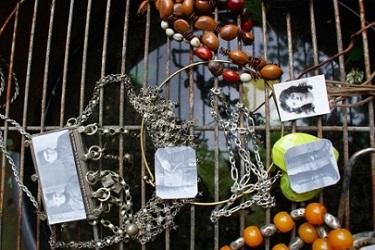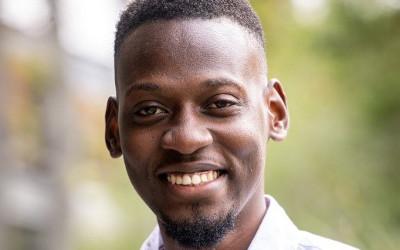Day 75, Year of #Mygration: We are all displaced

It is our sedentary bias, our belief that mobility and migration are the exception rather than the rule, which fuels this distrust of the mobile – but anyone can experience displacement.
Written by Dr Alena Pfoser, Loughborough University and Dr Sara de Jong, Open University.
Displacement marks our times. According to the UNHCR, there are currently 65.6 million people forcibly displaced worldwide. The New York Times ‘Refugees and displaced people’ section is filled with new articles about displacement in different regions of the world on an almost daily basis. At the same time, voices that problematise mobility and migration, not because of concerns with the plight of displaced populations, but out of protectionism and a desire to contain populations are becoming louder. The up- and unrooted are both considered suspect.
Last year, Theresa May infamously stated that “if you believe you’re a citizen of the world, you’re a citizen of nowhere” to insist on national ties and obligations. Already in 1992, Liisa Malkki, a Professor of Anthropology at Stanford University noted that it is our sedentary bias, our belief that mobility and migration are the exception rather than the rule, which fuels this distrust of the mobile. Writing about refugees, she argues that “refugees’ loss of bodily connection to their national homelands came to be treated as a loss of moral bearings. Rootless, they were no longer trustworthy as ‘honest citizens’"
Displacement as shared experience
But can displacement also be a resource for morality, connections and responsibility rather than a category of difference? The work of performance artist Natasha Davis, who recently showed her piece ’50 Rooms’ as part of the Tate Exchange programme ‘Who Are We?’, suggests that it can. Natasha Davis has been a prolific artist with over forty solo and collaborative projects presented in the UK and internationally across five continents. Her installation ‘50 Rooms’, which was exhibited in the Tate Modern and also became the stage of a one-off live performance, consists of a wooden cabinet with many drawers. In them, Natasha Davis collected her own memories and invited visitors of the ‘Who Are We?’ programme to contribute to the installation by sharing and depositing objects that linked them to certain places.
Visitors used the two empty boxes to add various objects of personal meaning to them, such as hats, scarves, notebooks, postcards, photographs, a piece of soap from Syria. Natasha’s own drawers contained wigs, feathers, a gas mask, old letters, grass, apples, an embroidery, jars with her hair, nails and jewellery, and various small props from her performances. With the cabinet drawers filling up with different memories, it was not the construction of one common place that connected people. Rather, it was the sharing of experiences of displacement, of growing roots and moving on, and of attachments across distances.
.jpg)
Beyond geographical displacement
Displacement, as migration and development scholar Oliver Bakewell has argued, is used to describe a process, a category and a condition. As process, it refers to the change of people’s physical location, as category it denotes a designated group of people, for instance, Internally Displaced Persons (IDPs). As a condition, however, it describes feeling out of place. As Bakewell notes, displacement as a state of being is not objective, but linked to people’s sense of themselves. It can therefore run counter to the official categories of “migrant” and “displaced person”. A migrant can still feel rooted and at home. A person who has never migrated can still experience the feeling of displacement.
Natasha Davis’s work takes this one step further. For her, displacement is an experience that cuts across migrants and non-migrants in other ways as well. As she explained in a conversation with us in the lead-up to her performance and exhibition at Tate Exchange, “When I work with participants around the issues of displacement, I look at this issue rather broadly, not only in terms of geographical displacement. For someone the displacement will be within their own body because of some changes they are going through, such as menopause or becoming deaf, for someone else it will be the displacement due to having a difficult family background or history of abuse. Someone else will have been in prison for a decade or two and the displacement will be around re-learning to live in the world that has changed since they last actively participated in it.”
Three of Natasha Davis’ earlier works, Rupture, Asphyxia and Suspended, use autobiographical elements, but shape them in a way that they can be easily identified with. In each of the performances, Natasha Davis shows the body in its displacement, following her interest “in the notion of the body being out of balance, literally and metaphorically”. Each time the displacement is of a different, but related nature, as she explains: “In Rupture this was cancer (the body falling apart in relation to the country falling apart), in Asphyxia this involved the breath, how the body performs when the breath is restricted and what can make us feel out of breath, such as crossing borders, family background, exilic history and so on. Suspended started with a clear visual image of me suspended in the space, with my hair attached to the theatre rig, unable to move until the audience cut the strings of my hair and release me into movement.” Suspended forced the audience to interact with the artist and participate - if they did not approach her to cut her free, the performance could not begin. Once started, the performance itself was a shared journey with audience members being encouraged to move from one installation to another.
The assumption that we all can connect to experiences of displacement since in one way or the other we all have been displaced resonates with a recent publication by anthropologist Gregory Feldman. In it, Feldman argues that migrant-hood has become a ubiquitous condition as uncertainty, atomisation and disempowerment (which have been commonly understood as characteristics typical of migrants’ existence) have spread across the general population. This can create the possibility for new relations: experiencing the same anxieties citizens and migrants can recognise each other not as strangers but as sharing similar struggles.
Connections through displacement
Natasha Davis’ work manages to hold together alienation, estrangement, and displacement, with participation, relationality and connectedness. Her work, as it has been remarked, “turns familiar territories of belonging strange and makes ruptured identities of exiles strangely familiar.” Someone who never moved but feels estranged from the family that she grew up in, could relate to some of the experiences narrated by a refugee that she meets.
Equally, a connection can be created by feelings of having been displaced in and estranged by their ‘own’ country. Writing in response to Theresa May’s vilification of the ‘citizen of nowhere’, the political scientist Rahul Rao describes the “zone of encounter” that he witnessed during a protest at an Immigration Removal Centre (IRC). During the protest a relationship was established “between people whose citizenship of nowhere has been thrust upon them and others whose alienation from the state of which they are citizens or legal residents compels them to extend their solidarity.” People experiencing very different forms of displacement, situated in both privileged and marginal positions, found each other in a shared insistence on the right to put roots down in multiple and different locations beyond those that are state sanctioned.
The condition of displacement needs no romanticisation. But if recognised as a more common than exclusive condition, it could form a point of connection that compels people to take responsibility for each other’s condition. If we are all displaced, in some ways, whether through bodily changes, geographical moves, alienation from our supposed roots, simple ‘us’ and ‘them’ categories don’t hold. Natasha Davis’ art shows us at an affective level that broadening displacement as a category of experience that can cut across different groups, has the potential of opening up space for new connections and solidarities.
This article was originally published on openDemocracy as part of an editorial partnership between openDemocracy, The Open University and Counterpoints Arts to reanimate the Tate Exchange project in which academics and artists together ask who – during a time when the lines marking out citizens, borders and nations are being redrawn, or drawn more starkly – 'we' are, and who gets to decide.
Dr Alena Pfoser, is Lecturer in Communication and Media Studies at Loughborough University and Dr Sara de Jong, is a Research Fellow at the Open University.
Quarterly Review of Research
Read our Quarterly Review of Research to learn about our latest quality academic output.

Contact our news team
For all out of hours enquiries, please telephone +44 (0)7901 515891
Contact details